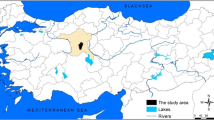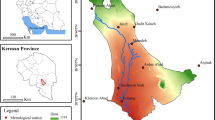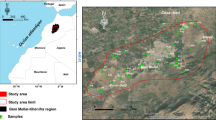Abstract
The aim of this study was to generate a land productivity dynamics (LPD) map of a degraded catchment located in sub-humid terrestrial ecosystem via a land degradation assessment using three indicators, namely land use and land cover, land productivity, and soil organic carbon density. The study was carried out in two adjacent microcatchments located in Gediz River Basin and conducted between 2001 and 2015. For this purpose, Landsat satellite images were used to determine changing of land use and land cover and vegetation density. In addition, 319 soil samples were collected from surface and subsurface soil depths to detect soil organic carbon density of the study area in May 2015. According to the study results, in more than 23% of the catchments’ area of approx. 3896 ha, land productivity is observed to decline while about 24% shows early signs of decline level. Some of these areas used under agricultural cropping, overgrazed pasture, and artificial areas showed evidence of soil erosion problem. Only very small area of the catchment shows stable and increasing land productivity dynamics trend during the 14-year period.








Similar content being viewed by others
References
Blake GR and Hartge KH (1986) Bulk density. In Klute, A. (ed). Methods of soil analysis. Part 1. Physical and mineralogical methods. 2nd ed. Agronomy 9: 363–382.
Bonneau LR, Shields KS, Civco DL (1999) Using satellite images to classify and analyze the health of hemlock forests infested by the hemlock woolly adelgid. Biol Invasions 1:255–267
Bouyoucos GJ (1951) A recalibration of the hydrometer method for making mechanical analysis of soils. Agron J 43:435–438
Braun-Blanquet J (1964) Plant sociology: the study of plant communities, 3rd edn. Springer-Verlag, Berlin-Wien-New York
Cambardella CA, Moorman TB, Novak JM, Parkin TB, Karlen DL, Turco RF, Konopka AE (1994) Field-scale variability of soil properties in Central Iowa soils. Soil Sci Soc Am J 58:1501–1511
Cherlet M, Ivits E, Sommer S, Toyh G, Jones A, Montanaraella L, Belward A (2013) Land productivity dynamics in Europe. Towards valuation of land degradation in the EU. JRC Scientific and policy Reports, p-61.
Congalton RG, Oderwal RG (1983) Assessing Landsat classification accuracy using discrete multivariate analysis statistical technique. Photogramm Eng Remote Sens 49:1671–1678
Congalton RG (1996) Accuracy assessment: a critical component of land cover mapping. In: Scott Jm, Tear TH, Davis F (eds) A landscape approach to biodiversity planning. American Society of Photogrammetric and Remote Sensing, Charlotte, North Carolina, pp 119–131
Demirel H, Ozcinar C, Anbarjafari G (2010) Satellite image contrast enhancement using discrete wavelet transform and singular value decomposition. IEEE Geosciences and Remote Sensing Letters 7:333–337
Dabelko G, Lonergan S, Matthew R (2002) State of the art review on environment, security and developmentc-operation. The World conservation Union for the Working Party on Development Co-operation and Environmet. OECD Development Assistance Committee.110p.
Edwards MC, Wellens J, Al-Eisawi D (1999) Monitoring the grazing resources of the Badia region, Jordan, using remote sensing. Appl Geogr 19:385–398
ERDAS (2003) Erdas Field Guide, 7thEdn edn. Leica Geosystems, GIS and Mapping LLC, USA
Gandhi MG, Parthiban S, Thummalu N, Christy A (2015) NDVI: vegetation change detection using remote sensing and GIS—a case study of Vellore District. Procedia Computer Science 57:1199–1210
GDRS (1984) General Directorate of Rural Services of Turkey Research Planning and Coordination Unit, Soil and Water Resources Research Directorate Land Inventory Report, Ankara.
Giuseppe E, Zucca C, Colombo VVF, Musinu S (2008) Traditional approach and remote sensing technologies in the development and implementation of desertification indictors. Combating desertification assessment, adaptation and mitigation strategies. In: Gabriels D, Cornelis W, Eyletters M, Holleboch P (eds) UNESCO chair of Eremology. Ghent University, Ghent
Hani A, Pazira E, Manshouri M, Kafaky SB, Tali MG (2010) Spatial distribution and mapping of risk elements pollution in agricultural soils of southern Tehran, Iran. Plant Soil Environ 56(6):288–296
Isaaks HE, Srivastava RM (1989) An introduction to applied Geostatistics. Oxford University Press, New York
Lal R, Safriel U and Boer B (2012) Zero net land degradation, a new sustainable development goal for RIO+20; a report prepared for the Secretariat of the UNCCD, May 2012.
Moller-Jensen L (1997) Classification of urban land cover based on expert systems, object models and texture. Computers. Environment and Urban Systems 21:291–302
Nelson DW, Sommers LE (1982) Total carbon, organic carbon and organic matter. In: Page LA, Miller RH, Keeney DR (eds) Methods of soil analysis, part 2. Chemical and microbiological methods, 2nd edn. American Society of Agronomy, Madison, WI, pp 539–579
Pla I (2008) Desertification under climate change and chancing land use in Mediterranean environment. Combating desertification assessment, adaptation and mitigation strategies. In: Gabriels D, Cornelis W, Eyletters M, Hollebosh P (eds) Published jointly by UNECO chair of Eremology. Ghent University, Belgium, pp 30–40
Retiere A, Sommer S, Minelli S, Byron-Cox R, Candelori M (2015) Land degradation neutrality from concept to practice. Using the UNCCD indicator framework to set LDN national voluntary targets and monitor their achievement. Methodological note. Joint Research Center, Italy, p 13
Rimkus E, Stonevicius E, Kilpys J, Maciulyte V, Valiukas D (2017) Drought identification in the Eastern Baltic region using NDVI. Earth System Dynamics Discussions 5:1–15. doi:10.5194/esd-2017–5:1–15
Sommer S, Zucca C, Grainger A, Cherlet M, Zougmore R, Sokona Y, Hill J, Della R, Peruta Roehrig J, Wang G (2011) Application of indicator systems for monitoring and assessment of desertification from national to global scales. Land Degrad Develop 22:184–119. Published online in Wiley Online Library (Wiley online library.com). doi:10.1002/ldr.1084
UNCCD (2016a) United Nations Convention to Combat Desertification. The Global Mechanism. Land degradation neutrality: the target setting program. p 22. Bonn, Germany.
UNCCD (2016b) United Nations Convention to Combat Desertification. Land Degradation Neutrality Target Setting Program. Land degradation neutrality target setting a technical guide, p 68. Bonn, Germany.
Acknowledgements
The authors thank to General Directorate of Combating Desertification and Erosion Ministry of Forestry and Water Affairs in Ankara, Turkey, for funding this project.
Author information
Authors and Affiliations
Corresponding author
Rights and permissions
About this article
Cite this article
Dengiz, O. Potential impact of land use change on land productivity dynamics with focus on land degradation in a sub-humid terrestrial ecosystem. Theor Appl Climatol 133, 73–88 (2018). https://doi.org/10.1007/s00704-017-2162-1
Received:
Accepted:
Published:
Issue Date:
DOI: https://doi.org/10.1007/s00704-017-2162-1




